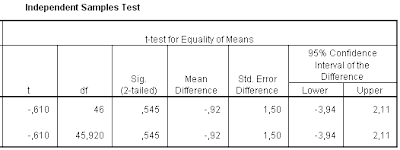When to chose "Unpaired t test"
General prerequisites:
- Goal of the test is to "Compare two unpaired groups".
- Type of data is "Measurement (from Gaussian Population)"
- n > 30
- random sampling.
- The two groups have approximately equal variance on the dependent variable. You can check this by looking at the Levene's Test.
- The two groups are independent of one another.
How to think about results from an unpaired t test
The unpaired t test compares the means of two groups, assuming that data are sampled from Gaussian populations. The most important results are the P value and the confidence interval.
The P value answers this question: If the populations really have the same mean, what is the chance that random sampling would result in means as far apart (or more so) than observed in this experiment?
Following is a sample output of an independent samples T test. We compared the mean scores of 48 students (24 male vs. 24 female).
First, we see the descriptive statistics for the two groups. We see that the mean for the "boys" group is approximately same as the "girls" group. That is, boys, on average, had taken same scores as girls.
Next, we see the Levene's Test for Equality of Variances. This tells us if we have met our second assumption (the two groups have approximately equal variance on the dependent variable). If the Levene's Test is significant (the value under "Sig." is less than .05), the two variances are significantly different. If it is not significant (Sig. is greater than .05), the two variances are not significantly different; that is, the two variances are approximately equal. If the Levene's test is not significant, we have met our second assumption. Here, we see that the significance is .793, which is greater than .05. We can assume that the variances are approximately equal.
Finally, we see the results of the Independent Samples T Test. Read the TOP line if the variances are approximately equal. Read the BOTTOM line if the variances are not equal. Based on the results of our Levene's test, we know that we have approximately equal variance, so we will read the top line.
Our T value is -,610.
We have 46 degrees of freedom.
There is not a significant difference between the two groups (the significance is more than .05).
Therefore, we can say that there is not a significant difference between the boys and girls groups. Boys and girls took approximately same scores from this test.
Türkçe
Bağımsız t testi
Genel koşullar:
- Amacımız "Bir grup ortalamasını başka bir grup ortalaması ile karşılaştırmak" olduğunda.
- Veri türümüz "Normal dağılımdan alınan bir örneklem" ise.
- n > 30
- Rasgele örneklem seçimi
- Bağımlı değişken cinsinden her iki grubun varyansları yaklaşık olarak aynı olmalı.
- Gruplar birbirinden bağımsız olmalı.
Bağımsız t testi grupların Normal Dağılımlı Evrenlerden örneklendiğini varsayarak ortalamalarını karşılaştırır. Testin sonucunda iki önemli değer olan P değeri ve df (güven aralığı) değerleri bulunur.
P değeri şu anlama gelir: Eğer iki grubun ortalamaları gerçekten aynı olsaydı bu örneklemlerde seçilen dağılımları gösterme olasılıkları ne olurdu? Daha basit ifadeyle: iki grubun varyansları homojen kabul edildiğinde aralarında anlamlı bir fark var mıdır?





0 Responses to When to chose "Unpaired t test"
Something to say?